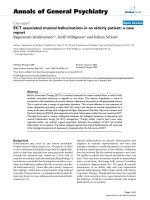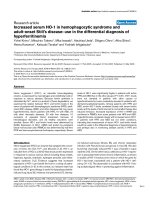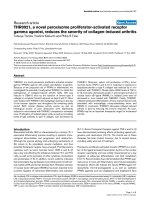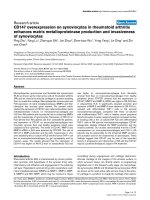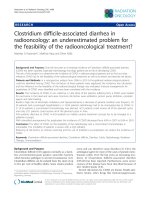Báo cáo y học: "Capturing real-life patient care in psoriatic arthritis and its risks: the challenge of analysing registry data" docx
Bạn đang xem bản rút gọn của tài liệu. Xem và tải ngay bản đầy đủ của tài liệu tại đây (41.86 KB, 2 trang )
Available online />Page 1 of 2
(page number not for citation purposes)
Abstract
Studies based on registries continue to inform us of many relevant
issues in the treatment of arthritic conditions and constitute more
than just a supplement of clinical trial data. We can learn about
long-term aspects of therapies beyond the scope of most clinical
trials and about larger-scale toxicity. The downsides need to be
considered in the interpretation of the results and include mainly
the biases that are inherent when routine clinical practice is just
observed and not steered by a protocol. However, using steered
protocols in practice not only would facilitate post hoc analyses of
clinical effectiveness, but (as we have learned from research in
rheumatoid arthritis) can also improve outcomes of our patients.
In a recent issue of Arthritis Research & Therapy, Saad and
colleagues [1] present a study on the persistence with anti-
tumour necrosis factor (anti-TNF) therapy in psoriatic arthritis
(PsA). And as is the case for most publications that stem
from registries, there will be those excited about learning
important real-life aspects of our therapies and there will be
those critical about it, citing all of the biases of observational
studies that can be reviewed in epidemiological textbooks.
What unites these different viewpoints is that we have
become increasingly aware in the past decades that there are
certain things and medical facts that we will never learn from
clinical trials, either because they are not able to address
them (for example, large-scale toxicity) or because they do
not want to address them (for example, comparative efficacy).
So what can we learn from the work of Saad and colleagues
[1] that we cannot learn from clinical trials?
To start with the most delicate question that can be posed:
Which drug is most effective, and which one is least toxic?
Usually, this issue is handled with a lot of care, as it is by the
authors of the current study, but the general impression
remains that infliximab might be inferior in regard to both
discontinuation rates for ineffectiveness and toxicity. This
conclusion, of course, is challenging, as the analysis of drug
retention rates often creates clinical paradoxes, such as the
one seen in rheumatoid arthritis (RA), in which methotrexate
retention rates seem to have decreased over the years. The
reason is that treatment termination, as the natural anchor for
analyses of retention rates, at least for lack of effectiveness,
has become a moving target [2]. In other words, a switch of
anti-TNF to a subsequent regimen can imply that clinical
disease activity was unacceptable, but it also includes the
clinical philosophy of what is considered ‘unacceptable’ at
the time of observation. For example, a large number of
potential spare regimens will lower the bar of intolerable
disease activity for treatment changes considerably. New
therapeutic options aside, the perception of disease activity
(and when it is deemed intolerable) changes over the years.
However, for the comparison of the three TNF inhibitors in
this study, we can probably only follow the line of arguments
by the authors that several reasons may exist that potentially
penalise infliximab in the comparison, with channelling bias
being one of them. We therefore might turn around and once
again raise our voice and call for comparative clinical trials.
Activities from registries like the British Society for Rheuma-
tology Biologics Register, which is sponsored by essentially
all of the pharmaceutical companies that are marketing
biologic therapies, indicate that there is some hope that one
day one or the other of these companies will take the
economic risk and engage in a head-to-head trial design of
different biologic drugs as well as in strategic trials involving
different biologic drugs. In this way, we eventually will be able
to learn more from trials than the fact that adding a new
therapy to methotrexate has superior efficacy than adding
placebo.
However, even then, the need for observational studies would
remain, and since comorbidity has been addressed in the
Editorial
Capturing real-life patient care in psoriatic arthritis and its risks:
the challenge of analysing registry data
Daniel Aletaha
Division of Rheumatology, Medical University of Vienna, Vienna, Austria
Corresponding author: Daniel Aletaha,
Published: 3 June 2009 Arthritis Research & Therapy 2009, 11:112 (doi:10.1186/ar2694)
This article is online at />© 2009 BioMed Central Ltd
See related research by Saad et al., />PsA = psoriatic arthritis; RA = rheumatoid arthritis; TNF = tumour necrosis factor.
Arthritis Research & Therapy Vol 11 No 3 Aletaha
Page 2 of 2
(page number not for citation purposes)
study by Saad and colleagues, it can serve as a very good
example for that: comorbidity usually is neglected and
excluded in clinical trials but is omnipresent in real life. Based
on the data in this study, the presence or absence of any
comorbidity has an impact on the occurrence of adverse
events that limit drug continuation. As an additional layer of
complexity, chronic arthritis causes comorbidity itself [3,4],
emphasising the importance of preventive arthritis care.
In regard to the issue of predictors, it seems to be another
paradox that higher disease activity levels were found to
better predict retention of TNF inhibitors. The potential bias
that these patients were likely to be more refractory can be
adjusted for in part, but it is difficult to allow for the clinical
‘gut’ feelings of rheumatologists, by which most of us would
tend to keep a patient on a given therapy if that patient has
already improved to some extent since the initiation of the
respective treatment. Showing such large amounts of
improvement is more likely for someone who started off with
higher disease activity than for someone coming from a lower
baseline, even if the patients have reached the same
unsatisfying endpoint. This might, at least in part, explain this
paradox. In RA, therapy steered by an index has become
more and more a mainstay of management as it has been
shown that it is not the level of improvement that is decisive
but rather the disease activity reached [5,6]. This helps to
develop and advance ‘gut’ decisions to more objectively
informed ones and will likely benefit patients with PsA.
One word on the power of statistical computation, which is
also perceivable in this study: the authors have adopted the
methodology of looking at all treatment terminations and then
at only those terminations for the reason of ineffectiveness
and terminated for the reason of toxicity. This was done by
censoring patients with treatment terminations other than the
reason of interest in the respective subanalysis. For example,
if survival of drug effectiveness is analysed, a patient with
toxicity-related termination of therapy will be considered to
have reached the end of observation without reaching the
outcome [7]. In this way, the observed period that was event-
free (that is, no ineffectiveness of the drug) can inform the
analysis. In contrast to stratification, this is an effective way to
incorporate observations on all patients in the analysis. The
dichotomy between ineffectiveness and toxicity as a
physician-reported reason for drug discontinuation carries
another problem: the issue of adjudication. Some patients
clearly will have unacceptable flares, and others clearly will
have unacceptable toxicity; however, the vast majority of
patients will have some combination of the two, which will
hamper a clear adjudication of the reason for withdrawal.
In summary, the study by Saad and colleagues gives us
important insights into daily-life use of TNF inhibitors in PsA, a
disease that too often is secondary to RA in the scientific and
clinical perceptions of rheumatologists. The authors deal
effectively with the challenges posed by the type and origin of
their data. Although toxicity and effectiveness analyses seem
to favour etanercept and adalimumab over infliximab, we need
to be cautious unless we have results from randomised
comparative trials.
Competing interests
The author declares that he has no competing interests.
References
1. Saad AA, Ashcroft DM, Watson KD, Hyrich KL, Noyce PR,
Symmons DPM: Persistence with anti-TNF therapies in
patients with psoriatic arthritis: observational study from the
British Society of Rheumatology Biologics Register. Arthritis
Res Ther 2009, 11:R52.
2. Aletaha D, Smolen JS: Threats to validity of observational
studies on disease-modifying antirheumatic drug therapies
for rheumatoid arthritis: new aspects after the fall of the
pyramid and the rise of new therapeutics. Curr Rheumatol Rep
2003, 5:409-412.
3. Pincus T, Callahan LF: Taking mortality in rheumatoid arthritis
seriously—predictive markers, socioeconomic status and
comorbidity. J Rheumatol 1986, 13:841-845.
4. del Rincon I, Williams K, Stern MP, Freeman GL, Escalante A:
High incidence of cardiovascular events in a rheumatoid
arthritis cohort not explained by traditional cardiac risk
factors. Arthritis Rheum 2001, 44:2737-2745.
5. Aletaha D, Funovits J, Smolen JS: The importance of reporting
disease activity states in rheumatoid arthritis clinical trials.
Arthritis Rheum 2008, 58:2622-2631.
6. Grigor C, Capell H, Stirling A, McMahon AD, Lock P, Vallance R,
Kincaid W, Porter D: Effect of a treatment strategy of tight
control for rheumatoid arthritis (the TICORA study): a single-
blind randomised controlled trial. Lancet 2004, 364:263-269.
7. Aletaha D, Smolen JS: Effectiveness profiles and dose depen-
dent retention of traditional disease modifying antirheumatic
drugs for rheumatoid arthritis. An observational study. J
Rheumatol 2002, 29:1631-1638.

